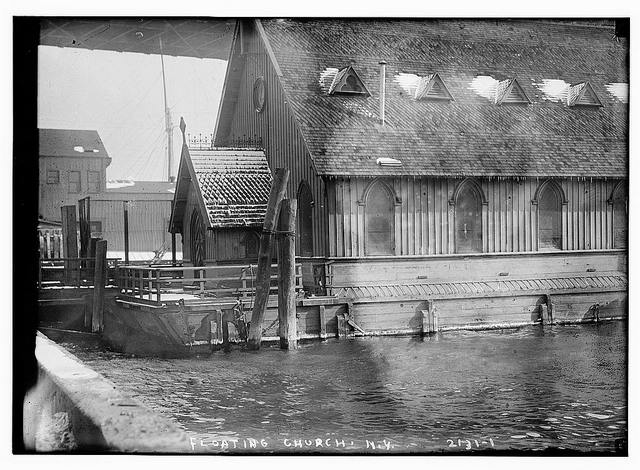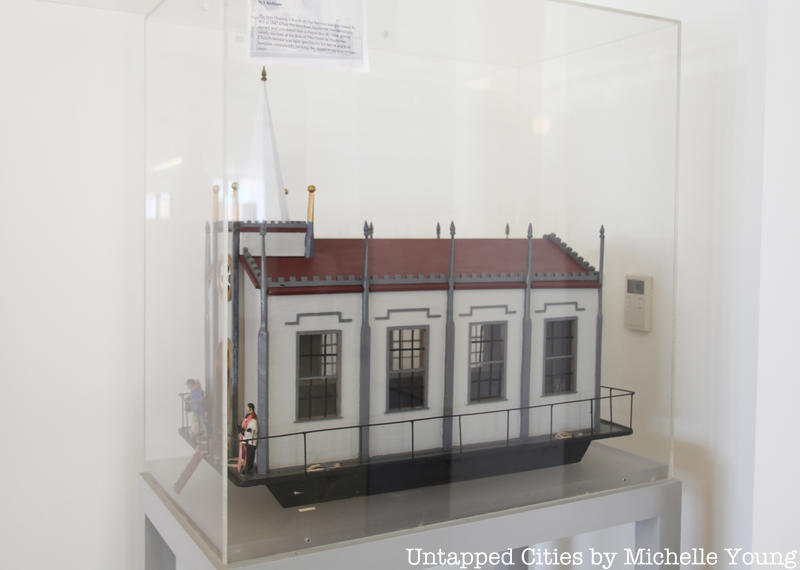 The second Church of Our Savior, via Library of Congress
The second Church of Our Savior, via Library of Congress
Drinking, cussing, and raising Cain: where have all the mariners gone? The pretty boys who come aboard during Fleet Week are so polite. But Manhattan’s no longer a port city, and the containerization of shipping has kidnapped shore leave: loading and unloading is so fast, seamen barely have time for the line at Starbucks. Untapped Cities mourns the old days, when carousing bands of sailors were still a threat to pure womanhood, and the only way to keep an old salt in line was with the dreadful terror of God. Meet the Seamen’s Church Institute and its floating churches.
The Seamen’s Church Institute was founded in 1834 by a group of Episcopalian sailors and operates to this day. Their first big project was the Church of Our Savior, a floating church moored off Pike Street in downtown Manhattan. [Note: Untapped Cities does not know to which city agency one should apply for a permit for a floating church…yet.]
The first Church of Our Savior, “an object of attention and a marked institution of our city,” according to quickly disintegrated and SCI scuttled in in 1866. A second Church of Our Savior was built, excuse me, floated, in the same spot in 1870.
The Church hosted services, a reading room, and a temperance society “which cheated the saloons of hundreds of victim.” SCI was not immodest about their contribution to sailor’s character: “his great improvement in bearing and general appearance is the manifest fruit of the Church’s enterprise on this line in his behalf.”
 A model of the first floating Church of Our Savior, purchased by the Seaman’s Church Institute in 1843 when the ferryboat Manhattan was decommissioned and converted into a chapel. The model sits in the Seaman’s Church Institute inside Port Newark
A model of the first floating Church of Our Savior, purchased by the Seaman’s Church Institute in 1843 when the ferryboat Manhattan was decommissioned and converted into a chapel. The model sits in the Seaman’s Church Institute inside Port Newark
In their heyday, SCI actually operated two floating churches. Besides the Church of our Savior in the East River, the Chapel of the Holy Comforter was moored in the Hudson. In 1868, when maintenance costs became excessive, SCI disposed of this church.
Lest you think our city has a monopoly on seaworthy chapels, the Seamen’s Church Institute of Philadelphia and South Jersey, founded along the lines of the New York Institute, also built a floating church in 1848, for the “unpolished mariners who felt out of place being in church next to well-dressed ladies.” Unfortunately, the turbid waters of the Delaware made everyone seasick, and this house of God barely lasted five years.
Though the last floating church of New York was towed away in 1910, but the tradition lives in at the Seaman’s Church Institute inside Port Newark (and it also lives on in London as a floating church). Here’s hoping some enterprising minister gets his sea legs under him and re-baptizes the Hudson.





